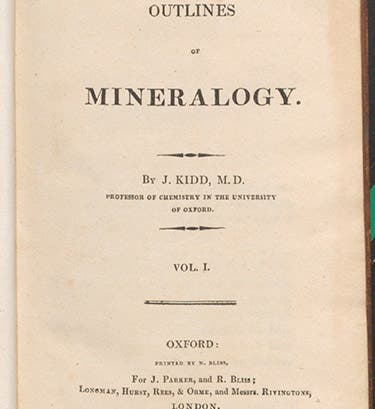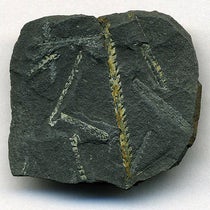Scientist of the Day - John Kidd
John Kidd, an English geologist, died Sep. 7, 1851, just shy of his 75th birthday (which would have been Sep. 10). Kidd was the founder of what has been called the Oxford school of geology, whose most notable figures were William Buckland, Charles Daubeny, and William Conybeare, all three of whom have been the subjects of entries in this series. Kidd was officially professor of chemistry at Oxford, a chair he assumed in 1803, but he had a keen interest in geology and mineralogy, and taught courses in those subjects at Oxford – taught Buckland, Daubeny, and Conybeare – until the regents finally took his suggestion and established a professorship in geology, which Buckland assumed in 1818.
We have three works by Kidd in our collections. The first is a two-volume work called Outlines of Mineralogy, published in 1809. I seldom write about mineralogical books, because they tend to be technical and unappealing to the general reader. They also usually lack illustrations. But Kidd found a way to make mineralogy interesting, because he liked to tell stories about minerals. For example, in discussing lead chromate (third image), he got the necessaries out of the way quickly (it can be scratched with a knife, is reducible by the blowpipe, conducts electricity, has a specific gravity of 6.02), and then related that the mineral was first discovered in Russia, in the Ural mountains, and it led directly to the discovery of chrome, a metal unknown until lead chromate was smelted. It is highly prized by artists as a yellow pigment. You can tell it from cinnabar (mercury sulfide), which it resembles, because when subjected to the blowpipe, it becomes a metal, whereas cinnabar is completely volatilized. And so forth. The book is actually quite enjoyable to read, and tells us, if nothing else, that for a chemist, Kidd knew quite a lot about both English minerals, and those of the continent.
Kidd discussed "rocks" at the very end of volume 2, where he included extensive sections on granite, basalt, limestone, etc. In the section on granite (fourth image), he revealed that he was not only familiar with the work of James Hutton, who thought that granite was an igneous rock that had slowly cooled from a molten state, but he was sympathetic to his conclusions. In this same section, he mentioned favorably the experiments of Gregory Watt, as reported in the Philosophical Transactions of the Royal Society of London in 1804, in which Watt formed granite-like rocks from molten material in the laboratory. Watt was the son of James Watt, and he died just after his paper was published, at the age of 27; Kidd is one of the few contemporary geologists who knew of his work and cited it favorably.
In 1815, Kidd published A Geological Essay on the Imperfect Evidence in Support of a Theory of the Earth. This was a late contribution to the "Theory of the Earth" genre, about which we mounted an entire exhibition a very long time ago (1984). Kidd is sometimes described as a scriptural geologist, one who finds the facts of geology compatible with the creation account in Genesis, but, like Buckland, he was far from fundamentalist in his leanings. However, he did feel that the state of geological knowledge in his time was too insufficient to support firm theories of the origins of rocks and strata (hence the "imperfect evidence" of his title), and since Scripture does provide certain knowledge, we should not too readily subscribe to conclusions about the Earth’s origin that contradict Scripture.
The third Kidd book in our collections was the second of what are often called the Bridgewater treatises, a prolonged attempt (8 volumes by 8 different authors) to demonstrate the wisdom of God through a study of some branch of his Creation. We discussed the Bridgewater treatises in detail in our post on Thomas Chalmers, another of the contributors. In a group photo of all 8 treatises (some two-volume), Kidd's is the third from the right, still in its original wrappers (sixth image).
Kidd turned increasingly to medicine in the mid-1820s, and his only influence on the geology of Charles Lyell came through Kidd’s students, Buckland and Conybeare (Lyell studied under Buckland at Oxford and knew Conybeare well). The portrait we show was clearly made later and does not show us the Kidd of the 1810s. But there is no portrait of Kidd in the National Portrait Gallery, nor any other that I could find. And I could not locate his grave. Not much survives of John Kidd, except for his books; we should be grateful we have those.
William B. Ashworth, Jr., Consultant for the History of Science, Linda Hall Library and Associate Professor emeritus, Department of History, University of Missouri-Kansas City. Comments or corrections are welcome; please direct to ashworthw@umkc.edu.












